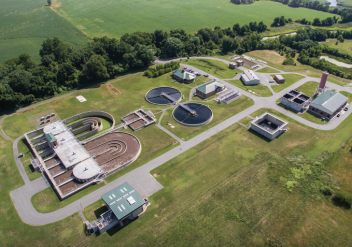Waste Not, Want Not: How Easton Utilities Transformed its Wastewater Treatment Plant into a Sustainability Campus

When Rebecca Saduk began working at Easton Utilities in early 2019, there were already plans to form an Environmental Stewardship Committee. Rebecca helped form the committee to support the utility’s sustainability goals and explore new opportunities to engage employees in stewardship activities. As Rebecca puts it, “It’s rewarding to empower employees with the knowledge and opportunities to take action.” Sustainability is now a part of the culture and helps the utility achieve multiple environmental, financial, and community benefits.
Inside the Sustainability Campus
Known as its Sustainability Campus, Easton’s wastewater treatment plant is an innovative facility that treats wastewater as a resource. Operations result in clean water, usable nutrients, and renewable energy. It is a model for sustainable wastewater management and demonstrates a coordinated effort by municipal, county, and state agencies to protect the environment, serve its citizens, and achieve economic benefits.
- Enhanced Nutrient Removal (ENR) Wastewater Treatment Facility: A state-of-the-art ENR system removes 85-95% of pollutants from the wastewater and is then disinfected with ultraviolet light before being released to local waterways. A byproduct of the treatment process is a dry, manageable organic material known as biosolids, which is sold to local farmers as fertilizer. The utility avoids paying for the hauling and disposal of the by-product, and revenue from the sale goes back into the plant’s operational budget where it can be used to maintain and operate equipment – ultimately, resulting in cost-savings for the customer.
- Solar Photo-Voltaic (PV) Array: Wastewater treatment facilities require large amounts of energy to operate. A 2-megawatt PV solar array at the site allows the utility to generate renewable energy instead of purchasing electricity from the grid. The array produces more than 100% of the energy needed to run the wastewater treatment plant, and the surplus is put back on the grid for public consumption. This sustainable, on-site energy generation results in cost savings to customers as well as a healthier environment.
- Wildlife Habitat: Two fields at the sustainability campus serve as important wildlife habitat for local fauna. One offers refuge for an endangered species of bird called the Black Rail while another houses pollinator gardens for butterflies and is home to two bee colonies.
Easton Utilities has sought several grant funding opportunities to help pay for their sustainability projects. Seeking external funding sources helps protect their rate payers from sharing in high project costs. Examples of programs that Easton Utilities have utilized include the USDA’s Rural Development program, Maryland Energy Administration’s grants, and Maryland Department of the Environment’s Energy Water Infrastructure Financing.
Employee Programs
Employees are encouraged to participate in a range of programs to protect the environment and give back to the community. A portion of the company’s end-of-year bonuses depends on whether environmental stewardship goals have been met.
- Annual Tree Planting: Each year employees plant 24 trees of 1 ½ - 2 inch caliper within the Easton Utilities service territory. Since 2008, Easton Utilities has planted over 330 trees within town limits.
- Invasive Species Control Program: Each year employees contribute 200 hours of time to conservation projects. In recent years education has focused on invasive species control, including training on how to identify and remove invasives safely and effectively. In past years employees have completed trash clean-ups, replaced street and traffic lights with LED lights, and installed electric vehicle charging stations downtown.
Looking Ahead
Easton Utilities is continuing to seek pathways toward smarter wastewater management through the following initiatives.
- Wind Study: Studies are currently being conducted to determine the amount of wind available to support the installation of a wind turbine to produce additional energy on site.
- Battery Storage: Various battery storage technologies are being explored to capture power when it is available, and then release it on demand.
- Educational Partnerships: Plans to partner with local schools and other institutions are underway to help educate the future workforce on the next generation of energy technologies.
Words of Advice
Rebecca offers these words of advice to small utilities.
- Don’t be intimidated. Being a small utility isn’t a bad thing. In fact, a substantial amount of funding is directed to water and wastewater systems that serve less than 10,000 people. While the application process for the grant programs may seem intimidating, I’ve had the most success with grant funding by sticking to the instructions and providing a clear and concise description of the project goals, objectives, and anticipated outcomes.
- Take advantage of partnership opportunities. Easton Utilities would not have achieved its sustainability goals without local partners and technical assistance providers. Some of these included the University of Maryland Bee Squad who inspect and maintain our bee colonies, local farmers who buy the biosolids end product as fertilizer, and the US Fish and Wildlife Service who designed and installed our pollinator gardens.
EFC’s interview with Rebecca Saduk is available as a podcast on EFCN’s Multimedia Library.
Learn more about environmental stewardship at Easton Utilities by visiting their website.
This article is based off an interview with Rebecca Saduk in September 2022.
